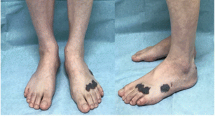Abstract
The insular cortex is considered one of the most complex regions of the brain, defined as the “hub” of somatosensory areas. Here, we examine the case of a surgically treated haemorrhagic cavernoma involving the middle and posterior insular cortex, presenting both sensory, gustative and speech symptoms. By reviewing the recent findings in humans’ and primates’ basic research, we illustrated clinical and radiological correlations of the reported case, confirming insular role in sensitive and gustatory functions.




Similar content being viewed by others
Abbreviations
- EEG:
-
Electroencephalogram
- CT:
-
Computed tomography
- MRI:
-
Magnetic resonance imaging
- PET:
-
Positron emission tomography
- fMRI:
-
Functional magnetic resonance imaging
References
Afif A, Chabardes S, Minotti L, Kahane P, Hoffmann D (2008) Safety and usefulness of insular depth electrodes implanted via an oblique approach in patients with epilepsy. Neurosurgery 62(5 Suppl 2):ONS471-9 (discussion 479-80)
Afif A, Minotti L, Kahane P, Hoffmann D (2010) Anatomofunctional organization of the insular cortex: a study using intracerebral electrical stimulation in epileptic patients: functional Organization of the Insula. Epilepsia 51(11):2305–2315. https://doi.org/10.1111/j.1528-1167.2010.02755
Afif A, Minotti L, Kahane P, Hoffmann D (2010) Middle short gyrus of the insula implicated in speech production: intracerebral electric stimulation of patients with epilepsy. Epilepsia 51(2):206–213. https://doi.org/10.1111/j.1528-1167.2009.02271.x
Baier B, Eulenburg PZ, Glassl O, Dieterich M (2011) Lesions to the posterior insular cortex cause dysarthria. Eur J Neurol 18:1429–1431. https://doi.org/10.1111/j.1468-1331.2011.03473
Benarroch EE (2019) Insular cortex: functional complexity and clinical correlations. Neurology 93(21):932–938. https://doi.org/10.1212/WNL.0000000000008525
Bjornsdotter M, Loken L, Olausson H, Vallbo A, Wessberg J (2009) Somatotopic organization of gentle touch processing in the posterior insular cortex. J Neurosci 29(29):9314–9320. https://doi.org/10.1523/JNEUROSCI.0400-09.2009
Cerliani L, Thomas RM, Jbabdi S, Siero JCW, Nanetti L, Crippa A, Gazzola V, D’Arceuil H, Keysers C (2012) Probabilistic tractography recovers a rostrocaudal trajectory of connectivity variability in the human insular cortex. Hum Brain Mapp 33(9):2005–2034. https://doi.org/10.1002/hbm.21338
Craig AD (2002) How do you feel? Interoception: the sense of the physiological condition of the body. Nat Rev Neurosci 3:655–666. https://doi.org/10.1038/nrn894
Evrard HC (2019) The organization of the primate insular cortex. Front Neuroanat 13:43. https://doi.org/10.3389/fnana.2019.00043
Henderson LA, Rubin TK, Macefield VG (2011) Within-limb somatotopic representation of acute muscle pain in the human contralateral dorsal posterior insula: somatotopy of muscle pain in insula. Hum Brain Mapp 32(10):1592–1601. https://doi.org/10.1002/hbm.21131
Hua LH, Strigo IA, Baxter LC, Johnson SC, Craig AD, (Bud). (2005) Anteroposterior somatotopy of innocuous cooling activation focus in human dorsal posterior insular cortex. Am J Physiol Regul Integr Comp Physiol 289(2):R319–R325. https://doi.org/10.1152/ajpregu.00123.2005
Isnard J, Guenot M, Sindou M, Mauguiere F (2004) Clinical manifestations of insular lobe seizures: a stereo-electroencephalographic study. Epilepsia 45(9):1079–1090. https://doi.org/10.1111/j.0013-9580.2004.68903.x
Kurth F, Zilles K, Fox PT, Laird AR, Eickhoff SB (2010) A link between the systems: functional differentiation and integration within the human insula revealed by meta-analysis. Brain Struct Funct 214(5–6):519–534. https://doi.org/10.1007/s00429-010-0255-z
Limanowski J, Lopes P, Keck J, Baudisch P, Friston K, Blankenburg F (2020) Action-dependent processing of touch in the human parietal operculum and posterior insula. Cereb Cortex 30(2):607–617. https://doi.org/10.1093/cercor/bhz111
Mazzola L, Isnard J, Peyron R, Guénot M, Mauguière F (2009) Somatotopic organization of pain responses to direct electrical stimulation of the human insular cortex. Pain 146(1):99–104. https://doi.org/10.1016/j.pain.2009.07.014
Mazzola L, Royet J-P, Catenoix H, Montavont A, Isnard J, Mauguière F (2017) Gustatory and olfactory responses to stimulation of the human insula: taste-odor and insula. Ann Neurol 82(3):360–370. https://doi.org/10.1002/ana.25010
Nieuwenhuys R (2012) The insular cortex: a review. Prog Brain Res 195:123–163. https://doi.org/10.1016/B978-0-444-53860-4.00007-6
Ostrowsky K (2002) Representation of pain and somatic sensation in the human insula: a study of responses to direct electrical cortical stimulation. Cereb Cortex 12(4):376–385. https://doi.org/10.1093/cercor/12.4.376
Ronchi R, Bello-Ruiz J, Lukowska M, Herbelin B, Cabrilo I, Schaller K, Blanke O (2015) Right insular damage decreases heartbeat awareness and alters cardio-visual effects on bodily self-consciousness. Neuropsychologia 70:11–20. https://doi.org/10.1016/j.neuropsychologia.02.010
Schaller K, Iannotti GR, Orepic P, Betka S, Haemmerli J, Boex C, Alcoba-Banqueri S, Garin DFA, Herbelin B, Park HD, Michel CM, Blanke O (2021) The perspectives of mapping and monitoring of the sense of self in neurosurgical patients. Acta Neurochir (Wien) 163(5):1213–1226. https://doi.org/10.1007/s00701-021-04778-3
Seeley WW (2019) The salience network: a neural system for perceiving and responding to homeostatic demands. J Neurosci 39(50):9878–9882. https://doi.org/10.1523/JNEUROSCI.1138-17.2019
Small DM (2010) Taste representation in the human insula. Brain Struct Funct 214(5–6):551–561. https://doi.org/10.1007/s00429-010-0266-9
Staszko SM, Boughter JD, Fletcher ML (2020) Taste coding strategies in insular cortex. Exp Biol Med 245(5):448–455. https://doi.org/10.1177/1535370220909096
Stephani C, Fernandez-Baca Vaca G, Maciunas R, Koubeissi M, Lüders HO (2011) Functional neuroanatomy of the insular lobe. Brain Struct Funct 216(2):137–149. https://doi.org/10.1007/s00429-010-0296-3
Woolnough O, Forseth KJ, Rollo PS, Tandon NE (2019) Uncovering the functional anatomy of the human insula during speech. eLIFE 8:e53086. https://doi.org/10.7554/eLife.53086
Author information
Authors and Affiliations
Corresponding author
Ethics declarations
Ethics approval and consent to participate
All procedures performed in studies involving human participants were in accordance with the ethical standards of the institutional and/or national research committee and with the 1964 Helsinki Declaration and its later amendments or comparable ethical standards. For this type of study, formal consent is not required.
Conflict of interest
The authors declare no competing interests.
Additional information
Publisher's note
Springer Nature remains neutral with regard to jurisdictional claims in published maps and institutional affiliations.
This article is part of the Topical Collection on Vascular Neurosurgery—Other
Rights and permissions
About this article
Cite this article
Marcati, E., Ferrari, E., Fava, E. et al. Clinical considerations on a right operculo-insular cavernous angioma: an illustrative case. Acta Neurochir 163, 2755–2759 (2021). https://doi.org/10.1007/s00701-021-04947-4
Received:
Accepted:
Published:
Issue Date:
DOI: https://doi.org/10.1007/s00701-021-04947-4




